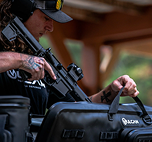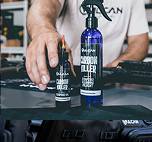Keeping your rifle clean and dry is one thing. Making sure its case doesn’t leak? That’s where many people run into problems. A rifle case is your first line of defense against wet weather, dust, and grime. If water sneaks in through a weak seam or a worn zipper, it can put your gear at risk quickly. Even something as small as a crack along the edge can let in moisture and eventually lead to rust or wear.
Whether you’re headed to the range, taking a trip, or training in the field, a waterproof rifle case is supposed to help, not create new problems. Over time, zippers may loosen and lining materials break down. If you’re noticing anything suspicious, it might be the perfect time to seal up those weak points. Fixing the issue now can prevent bigger damage later on.
Identifying Leaks In Your Rifle Case
Before you start fixing anything, knowing where the leak is coming from is the first step. Some leaks are easy to spot. Others are more subtle and need a thorough check. Begin with a bright light and open spaces. Look closely at every seam, zipper, and corner of the case, both inside and outside. Even the smallest leak can ruin parts of your gun.
Here are some common signs to look for:
1. Damp spots, especially around seams and zippers
2. Rust or oxidation on gun parts after storage
3. Water marks, unusual stains, or musty smells inside the case
4. Cracks in the lining, separated seams, or damaged zippers
The paper towel method is a helpful way to confirm your suspicions. Place several dry paper towels inside the rifle case. Close it completely, then gently splash water across the top and sides using a hose or light pour. After a few minutes, check the inside. Wet towels reveal exactly where water is sneaking in.
Also take time to press your hand along softer internal parts. Feel for dampness or unusual squishiness. Some fabric holds water without showing visual signs. If it feels wet or smells funky, your case may be absorbing moisture in hidden areas.
Tools And Materials You'll Need
Once you've figured out where the trouble lies, it’s time to set up your repair zone. Coming prepared cuts down on the time it takes and makes sure the job is solid. Skipping steps or using poor materials might cause more leaks later.
You’ll need the following items:
1. Waterproof sealant meant for soft cases or outdoor fabric
2. Rubbing alcohol or a surface cleaner that gets rid of oils
3. A clean, lint-free rag or towel
4. Cotton swabs for tight or narrow sections
5. Small brush or sponge-tipped applicator
6. A pair of gloves to protect your hands
Make sure your rifle case is bone dry before applying anything. Moisture will prevent sealants from bonding to surfaces. Use the rubbing alcohol to scrub the repair area. This removes oils, dirt, and leftover residues. Give it a minute or two to evaporate completely.
With sealants, don’t go cheap just to save money. Look for a high-quality option used on tents, outdoor gear, or soft gun cases. The sealant should be tough but flexible once dry. That flexibility means your case can still bend and stretch without the fix cracking apart. Tools like a soft brush or sponge give better control, especially along seams or detailed corners.
Step-by-Step Guide to Sealing Leaks
After you've cleaned the area, it's time to patch that leak. Follow these steps one by one for the best results.
First, double-check that the surface around the leak is clean and completely dry. Moisture under the sealant will weaken the bond and can trap water inside. Dip a clean rag in rubbing alcohol and scrub the damaged area. Even invisible dirt or grease can prevent the sealant from sticking.
Next, apply the sealant using a sponge, brush, or small tool. Spread the sealant evenly across the leak, extending just past the edges of the damaged area. This adds extra protection and lowers the chance of future leaks. Pay special attention to seams or around zippers where leaks are more common. Use cotton swabs to press the sealant deep into those points for a tighter seal.
Once applied, allow the sealant to dry as recommended on the product packaging. Most rubber-based or fabric-friendly options require several hours or even a full night. Don’t rush this step. A well-dried seal is much more likely to hold up under daily use.
Do a quick inspection once it’s dry. Gently flex the fabric to make sure the sealant stretches without peeling or cracking. Press on the surface a few times to check for soft spots or sticky patches that didn’t cure properly.
Testing and Maintaining Your Sealed Rifle Case
After giving everything a proper dry time, move on to testing. The goal is to confirm the patch is now watertight. One simple test is the water immersion check. Lightly place the fixed section into a tub or bucket of water. Don’t submerge the whole case unless absolutely sure. Watch closely for bubbles coming out from the seams or sealed zones. No bubbles means no leaks.
After a successful test, regular upkeep is what keeps future problems away. Make it a habit to inspect your case every few weeks or after any big outdoor adventure. Look over familiar weak spots like seams, folds, and zipper ends. Clean any debris right away.
Helpful maintenance tips:
1. Store your rifle case in a cool, dry space
2. Avoid dragging it over sharp or hard surfaces
3. Wipe it down if it gets wet or dirty
4. Open it up every once in a while to let air circulate
5. Touch up worn spots with sealant before they become problem zones
With just a little effort, your sealed case will keep running strong and protect what matters inside.
Keeping it Strong with VULCAN Arms
Once your rifle case is restored and sealed, you get the peace of mind that your gear's protected from weather, dirt, and grime. A sealed case means fewer worries when you’re out doing what you love.
At VULCAN Arms, we understand what shooters need from their storage gear. Our waterproof rifle cases are tough, trustworthy, and designed to deal with rough use. Whether you're packing gear for a hunt, heading to the range, or transporting across states, our WeatherLock line is made to work hard.
We built our line so your firearms stay safe in the roughest conditions. Protecting your equipment doesn’t end with cleaning your gun. That case matters more than most people think. When you use a sealed, weather-resistant rifle case, every trip becomes less stressful. You know your gear is dry, secure, and ready when it's needed.
To keep your gear protected no matter the forecast, check out our latest waterproof rifle case models designed to withstand the elements. With dependable performance and rugged durability, VULCAN Arms has what you need to transport and store your firearms with confidence.









Share:
When QuickMag Needs Remounting
Adjusting Car Handgun Holster Position